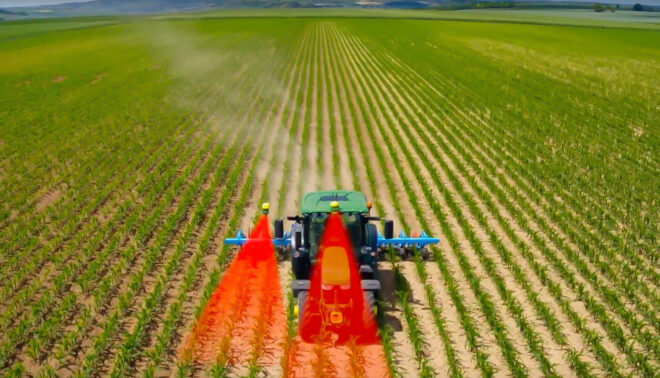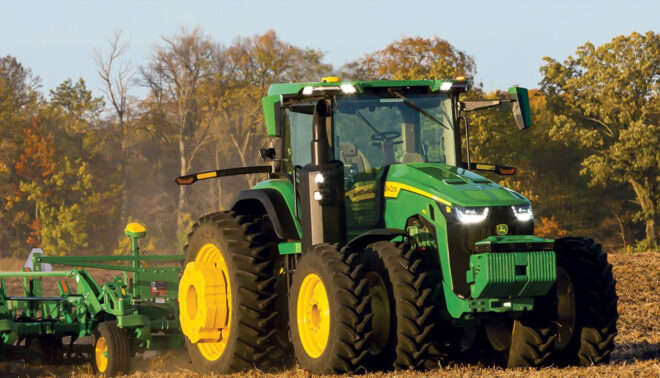What challenges does agriculture face globally?
World population is estimated to reach 10 billion people by 2050 which will lead to a 50% increase in demand for food. More animal products will be needed in the future and up to 70% more plant-based food will have to be produced – on the same or perhaps even less land. In Germany alone, the equivalent of 73 football fields of agricultural land is lost every day.
This increased production has to be managed with fewer workers because qualified personnel are in short supply. A farm with 2,500 ha, which is not uncommon in the USA, South America, and Eastern Europe, cultivates up to 100 million tonnes of crops which create significant labour demands.

Stefan Stahlmecke, Regional Director Intelligent Solutions Group at John Deere
What does this mean for farmers today?
Farmers are cultivating larger areas, but it still comes down to each individual plant. Providing it with the right amount of nutrients, keeping it free of fungi and insects, and ultimately harvesting it safely.
And it can feel like a race against time. During planting or sowing, the farmer has about 10 days to put the seeds into the ground and missing this window will have a negative impact on the yield. During the growth phase, weeds can grow up to 10cm per day leaving farmers with little time to apply crop protection and prevent the weeds from taking nutrients away from the crop. Farmers spend around 60-70% of a crop’s production cost on seeds, fertiliser, and crop protection chemicals.
In short, this means a significant number of impactful decisions must be made throughout the season. So how can farmers achieve the goal of increasing production and the quality of food while reducing artificial inputs like fertiliser and pesticides?

Mineral fertiliser spreading following the crop zone concept.
The goal of modern agriculture – agriculture 4.0, the fourth agricultural revolution – is to respond to the needs of each individual plant to optimise crop inputs and outputs. But the reality is that, on some farms, crops are treated as fields and viewed as homogeneous units – sown, fertilised, sprayed and harvested in a uniform manner.
However, our sector is working hard to change this practice and precision farming methods have been implemented on many farms.
What is the next step towards an Agriculture 4.0?
Site-specific cultivation of fields is more precise than traditional methods and better responds to the needs of the crop – but it’s still a long way from individual crop treatment. Higher precision methods, enabled by digitalisation, can achieve the goal of treating crops on an individual plant basis and help farmers to maximise production while becoming more sustainable.
The picture demonstrates the zone concept, a high precision method, and shows a tractor with a sensor attached to the front and a mineral fertiliser spreader at the rear. The sensor, equipped with a multispectral camera, measures the chlorophyll content of the crops and estimates the amount of biomass. This is then translated into a nutrient requirement and the amount of fertiliser being spread can be adjusted according to the needs of the crops in the zone.
And application rates can be determined even more precisely if, for example, historical biomass maps, recorded by satellites, are used to compare historical and the real-time status of the individual zones.

With the help of NIR technology, liquid manure can be applied almost as accurately as mineral fertiliser.
What role does the sensor technology play in this?
In another example of zone fertilisation, the mineral fertiliser spreader is replaced by a slurry tanker. Near-infrared (NIR) technology can be used to measure ingredients such as nitrogen, phosphorus and carbon dioxide (CO₂), allowing liquid manures like slurry to be used almost as precisely and specifically as mineral fertiliser. Another advantage is that it cuts down on CO2 emissions.
With all the high-tech, is there still room for mechanical weed control?
Yes, and rows can be treated individually. Weeds can be mechanically managed with a hoe, which is guided precisely between the rows by using a camera and a double-acting cylinder on the tractor’s draft link. The system makes it possible to move between rows quickly and achieve a similar level of productivity as when spraying.
However, hoeing the soil will still produce a level of carbon emission and demonstrates how finding the perfect solution is not always easy.
Let’s take a look into the future. What is possible?
One example is a self-propelled sprayer fitted with 36 cameras that can take pictures of individual plants and identify them as a weed or a crop plant. This is achieved by a comparison of real-time images to a bank of images within the technology’s software. Plants identified as weeds can then be target sprayed by individual nozzles, avoiding spraying the crop. A system like this can reduce herbicide use by up to 90%.
And how will machinery be operated in the future – will the farmer aspect be replaced?
There are already fully autonomous tractors equipped with six special cameras that recognise the environment and accordingly till the field without anyone in the cab seat. These machines are equipped with a lot of technology and sensors.
But trust is important; our industry has to earn it and that doesn’t happen overnight, but trust is the essential prerequisite for autonomous systems. It doesn’t mean farmers will no longer have field tasks in the future, but instead they’ll be able to devote themselves to other tasks, and we can help them make decisions with greater certainty.




